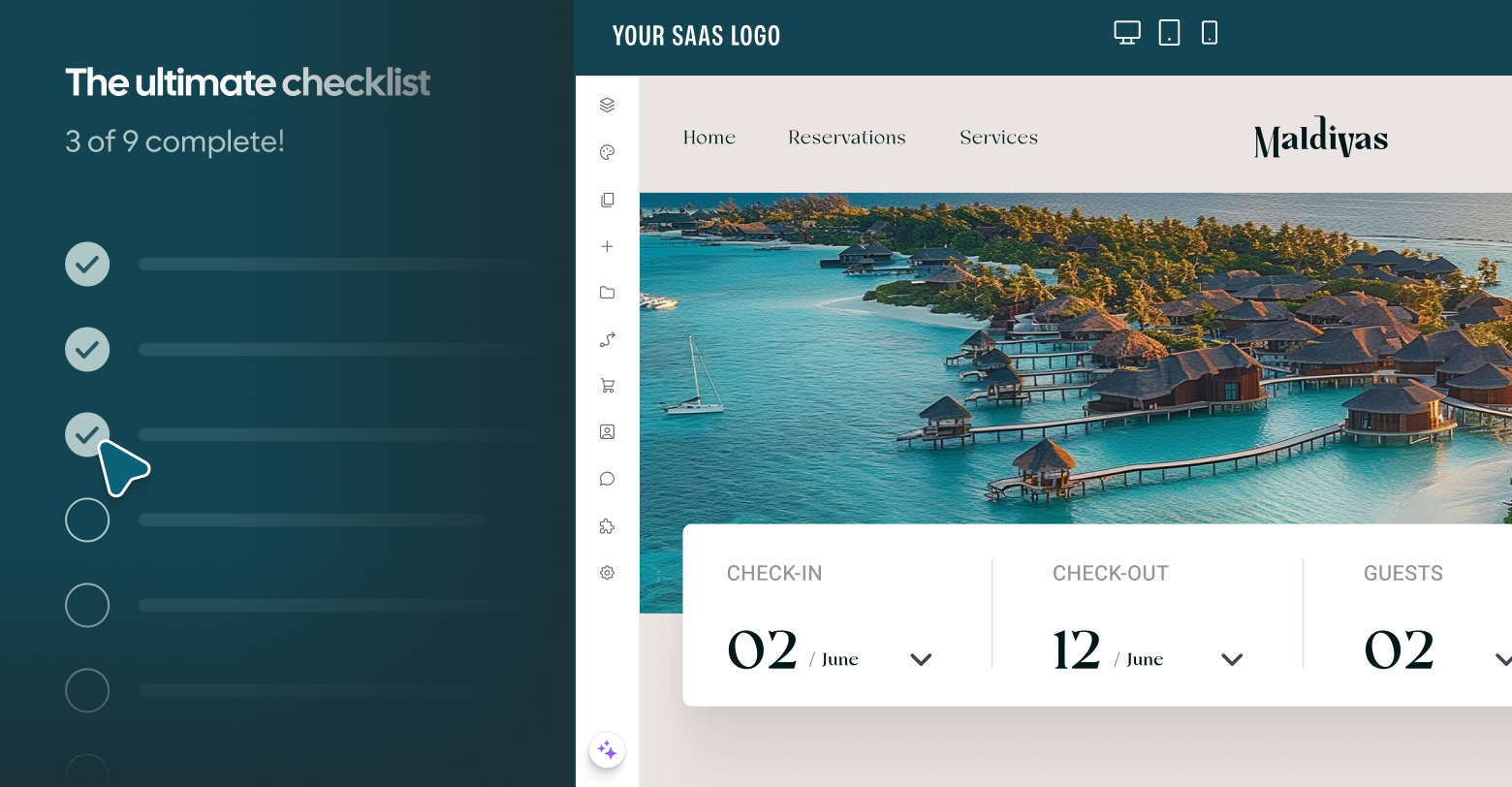So, you made the decision to shop for a
website builder for your SaaS platform.
Great decision!
Now what?
Yes, that’s right! You need to choose the right website builder, which is not an easy task with so many builders out there.
The right builder can take your SaaS platform to the next level, offering seamless integration, enhancing product adoption and user experience, and increasing revenue, while reducing churn. On the flip side, the wrong choice could lead to broken integration, clunky performance, limited customization, and headaches down the line.
To make sure you're choosing the best option, you'll need to carefully evaluate your options based on specific criteria. That's why we've created
the ultimate checklist—to help guide you through the process of selecting just the right website builder that aligns with your SaaS needs.
Ensure seamless integration to the last detail.
Seamless integration should be at the top of your checklist.
While "seamless integration" has become something of a buzzword, it refers to the ability to combine your SaaS product with the website builder in a way that works uniquely for you and your customers. The right builder should allow for custom integrations tailored to your product. Whether it’s enabling unique workflows, supporting specific customer interactions, or syncing critical data, the builder must be adaptable enough to meet your specific requirements.
Effortless integration isn’t just an ideal—it’s achievable. It can reduce friction for both your team and your customers, creating a cohesive user experience across your entire platform.
There are many aspects of integration to consider, but they all start with a robust, flexible and well documented API. With Duda’s API, for example, you can integrate your core solution with your customers' websites. If you have a booking engine, you can offer websites that have your booking system embedded within them. You can also incorporate user data, ensuring that your customers’ details are already synced with their websites.
Additionally, advanced tools such as Duda’s
Dynamic Pages allow you to create multiple pages from a single design, populated with user data. Think real estate listings, team pages, recipe collections, catalog items, and landing pages—all dynamically generated from a single source. Duda’s
Custom Widget Builder is another tool to take into consideration. Rarely will a website builder fit every SaaS company perfectly right out of the box. That's where custom widget creation comes into play, allowing your team to create custom functionalities without heavy development work, ensuring that even complex or region-specific features are easy to implement. Moreover, widgets created with such a builder should be optimized for performance, regardless of their number or complexity on a site.
To learn more about Duda’s deep integration capabilities, check out this
blog post series.
Brand the website builder with complete white-label capabilities.
While this topic could fall under integration, it absolutely deserves its own section. When selecting a website builder, comprehensive white-label functionality is essential, giving you full control over your customers’ experience.
A fully white-labeled solution ensures that your branding—not the website builder’s—is front and center throughout every customer interaction. You should have the ability to fully brand the platform, so it appears as a seamless extension of your own SaaS offering.
For example, a strong white-label solution would allow you to customize everything from the client login page to the website editor interface, and even the dashboard your clients use to manage their sites. The flexibility to brand automated emails, website preview tools, and even the features within the editor itself ensures that your customers see only your brand throughout their user journey.
Ensure your customers' websites rank high.
Here, you need to do some digging. Everyone claims they have top performance, but you should really check who’s just talking and who’s actually walking the walk. The performance of the website builder you choose will directly impact your users’ experience and, ultimately, their satisfaction with your SaaS product.
Strong
SEO is critical.
Of course, there are specific features to look at, such as automated sitemaps, and structured data integration, to name a few. These tools help search engines understand and index your content more efficiently. Additionally, page load speed and mobile-friendliness are both crucial factors for strong SEO performance.
And then there’s Google’s Core Web Vitals. These metrics are essential for evaluating user experience and are increasingly important for SEO.
Guess who’s leading the way in this set of metrics?
Do your due diligence. By digging into the performance and reputation of different website builders, you'll discover which ones excel in SEO and Core Web Vitals, and which fall short.
Safeguard your customers.
With the increasing frequency of cyberattacks, it’s essential to partner with a builder that offers enterprise-grade
security to protect your users and data.
There’s one website builder that is the most hacked on the internet (it rimes with “mess”).
In contrast, platforms like Duda provide reliable hosting (with no extra charge) and infrastructure that offers enhanced security features, including over 99.9% uptime to ensure consistent accessibility and reliability, DDoS protection to safeguard against Distributed Denial of Service attacks that could overwhelm and disrupt the site, and automated HTTPS encryption that offers free, automatic SSL certificates to secure data transmission and boost user trust.
Bottom line: you can’t compromise on security—it will come back to bite you in the ass.
Design with ease and flexibility.
We’re in the web design business, after all.
Design flexibility is essential when selecting a website builder, especially for a SaaS platform that demands both versatility and ease of use. When offering websites to your customers, you want a builder that allows them—or you, depending on who’s building—to create genuinely stunning websites effortlessly.
A top-tier builder should offer a broad selection of professionally designed templates that cater to various industries and needs. Moreover, the ability to design without coding knowledge, accommodating every skill level, is a significant advantage. Duda’s Editor 2.0, our most powerful editor yet, enables users to create sophisticated websites using an intuitive interface. This flexibility allows users to implement advanced features and make design adjustments with ease, without needing to write code unless they choose to. The Editor 2.0 further enhances this experience by providing advanced tools for precise customization, allowing you to craft tailored designs that stand out.
Power your customers' websites with advanced AI capabilities.
Efficiency is the name of the game, and in the AI era, everybody knows it. It’s not just your efficiency and productivity that you must ensure is supported—it’s also your customers’. They expect you to be at the forefront of innovation and specifically offer AI options.
The question remains: which AI options? While AI website builders are increasingly common, very few are tailored to the unique needs of SaaS companies that manage multiple websites.
Duda’s AI Assistant stands out by providing advanced AI capabilities designed for high-volume scenarios. Features like automated generation of meta tags and alt text for all site pages and images streamline bulk tasks, making it easier to manage numerous websites efficiently. This volume-focused approach ensures that you can deliver high-quality, optimized websites quickly and at scale, meeting both your needs and those of your customers.
Get full support in your business model.
Whether you offer self-service DIY websites, empowering clients to build their own sites, or provide full-service custom websites (DIFM), or both, your website builder must support your unique business model and technical requirements.
Flexibility is key—whether you're delivering hands-on service or giving your clients the freedom to design independently, the platform should adapt seamlessly to your approach.
Duda caters to all models by offering the tools and infrastructure necessary to scale, whether your focus is on customers empowerment or delivering complete, custom-built solutions. From intuitive interfaces for beginners to advanced customization options for professional developers, the platform ensures that your business can thrive, no matter which service model you choose. Moreover, you can build upgrade flows for customers who start in a DIY path so you can upsell them advanced options.
Avoid maintenance headaches.
One of the most overlooked yet critical aspects of selecting the right website builder is how it handles ongoing maintenance. The wrong choice can quickly turn into a time-consuming nightmare, with constant updates, plugin conflicts, and site downtime disrupting both your operations and customer satisfaction.
That's why opting for a platform that minimizes maintenance is essential. With Duda, there are no plugins to update and no risk of breaking functionality when they aren't maintained. This built-in approach ensures that your customers' websites stay up-to-date, secure, and fully functional without the need for constant monitoring or manual intervention.
So focus on what really matters—growing your SaaS business and improving customer experiences—while leaving the maintenance headaches behind.
Choose a platform that chooses you.
At the end of the day, you need a website builder that prioritizes you as a client, and actively works for you, your business model, and your customers. The right platform should understand the unique challenges SaaS companies face and offer tailored solutions that not only streamline your processes but also elevate your offering.
Duda is that platform—designed with your needs in mind, whether it's seamless integration, white-label capabilities, advanced AI features, hassle-free maintenance, or else.
Get in touch to learn more about our SaaS solution.







